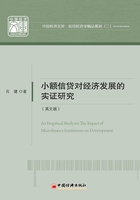
2. Microfinance Institutions (MFIs)
MFIs are the organizations which offer microfinance services and products to poor people. MFIs are organized by many different types: legally recognized MFIs and credit cooperatives, NGO, savings, and microfinance banks. According to Dr. Dragan Loncar, "MFIs varying the size, which the largest MFIs service over 10 million clients and the smallest MFIs service less than 10 clients."(7) MFIs offer not only basic financial services such as saving accounts, credit products, and insurance, but also offer other services such as training skills development, or a specific program to deal with local issues, such as women empowerment programs in Kenya.
"MFIs offer many help programs in rural areas, such as children labor and education program in Africa, women empowerment programs in Malaysia, etc. When poor people or families face a need, they don't have enough money, so they must borrow money from someone else. Poor households or families borrow money to help them save and to accumulate assets. After the costs incur, poor people or families must repay those loans by saving. MFIs should fund poor people's loans through savings that would help poor people or families manage their myriad risks".(8)
2.1 History of MFIs
"In the 1970s, microfinance began aiming to provide financial services that could help poor people to reduce their poverty."(9) Such was the case of the Bangladeshi's Grameen bank, which provided financial services to more than 7 million poor women. This sends the message that Microfinance Institutions can help poor people by relieving poverty. Poor people could receive loans from Microfinance Institutions. "Expanding the number of MFIs available to poor people and strengthening the capacity of those institutions are the best way to make sure poor people have access to financial services. In recent years, there is an increase on expanding the diversity of MFIs, because the more diverse that MFI's are, the more that they could serve the needs of different people". (10)
The Consultative Group to Assist the Poor learned some experiences from poor people and summarized a principle as follows: "CGAP (the Consultative Group to Assist the Poor) is an organization that includes 34 global partnerships that seek to promote financial services outreach to poor people. CGAP, through practical research, exchanges ideas with financial service providers, policy makers, and funders to develop creative solutions to help poor people. CGAP found evidence that poor people need to reach financial services so that they can improve their lives in the face of different and unexpected risks."(11)
First, poor people not only need loans, but also need money transfer services, saving and insurance. Second, MFIs are a way to help poor people who raise savings, build up assets, income and buffer themselves against unexpected shocks. Third, "Government subsidies and charity are scarce and they cannot always be relied upon to reach those in need."(12) As a result MFIs must support them so that they can become self-sufficient. Fourth, Microfinance Institutions build up permanent local institutions and bring the poor people's financial needs into a country's financial system. Fifth, a government's duty is to enable financial services and is not to offer a way to serve the poor people. A higher interest rate will hurt the poor people who break off the supply of loans. Sixth, MFIs should be considered as a useful tool for economic development and helping poor people to reduce poverty.
"MFIs should be distinguished from charities and should always measure and show their financial and social performance to the public. Poor people are so poor that they are impossible to generate cash flow, which Microfinance Institutions require for poor people to repay a loan, which should be treated as a donation. The new MFIs try to offer an increasing need for the diverse financial services for poor people and satisfy a variety of regions where poor people live and work. MFIs have four general categories of providers and all aim to provide poor people financial service needs. First, moneylender, savings collector, money-guards, and pawnbroker are all informal financial service providers. Second, credit unions, self-help groups and lots of hybrid organizations that are generally small and local, which means that the variety of hybrid organizations can offer convenience and flexibility to poor people for all member-owned organizations."(13) For instance, one member-owned organization is Grameen Bank. The Grameen Bank is managed and operated by poor people. So the Grameen Bank operation costs are low. However, these MFIs may run into some serious troubles due to a lack of financial skill when they face an economic crisis or operations or organizations become too complex. Those typed MFIs need to be supervised and regulated. Third, formal Microfinance financial institutions include commercial banks, savings bank, a state bank and other banks. Those types of MFIs are regulated and supervised by the government. They provide a variety of financial services, which can reach out the country and internationally. However, these Microfinance Institutions are facing high operation costs. "Those types of Microfinance Institutions are impossible to provide financial services to the poor or rural areas."(14) Fourth, commercial banks interested in microfinance by a trade credit. Those types of MFIs can be regulated and supervised by the government.
2.2 MFIs' Benefits
MFIs produce many benefits for poor people. Their accessibility is one of the benefits. Commerce Banks won't extend loans to people with few or no assets and don't provide a small loan when it is associated with microf-inance. "MFIs are providing small amounts of credit to poor people, which they believe even small amounts of credit that can help to reduce poverty.Other benefits from MFIs are that it provides opportunities, such as extending education and jobs."(15) For instance, poor families receiving Microfinance loans are less likely to force their children out of school due to economic reasons.